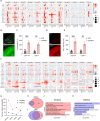A single-cell transcriptomic atlas of sensory-dependent gene expression in developing mouse visual cortex
- PMID: 40018816
- PMCID: PMC12599534
- DOI: 10.1242/dev.204244
A single-cell transcriptomic atlas of sensory-dependent gene expression in developing mouse visual cortex
Abstract
Sensory experience drives the maturation of neural circuits during postnatal brain development through molecular mechanisms that remain to be fully elucidated. One likely mechanism involves the sensory-dependent expression of genes that encode direct mediators of circuit remodeling within developing cells. To identify potential drivers of sensory-dependent synaptic development, we generated a single-nucleus RNA sequencing dataset describing the transcriptional responses of cells in the mouse visual cortex to sensory deprivation or to stimulation during a developmental window when visual input is necessary for circuit refinement. We sequenced 118,529 nuclei across 16 neuronal and non-neuronal cell types isolated from control, sensory deprived and sensory stimulated mice, identifying 1268 sensory-induced genes within the developing brain. While experience elicited transcriptomic changes in all cell types, excitatory neurons in layer 2/3 exhibited the most robust changes, and the sensory-induced genes in these cells are poised to strengthen synapse-to-nucleus crosstalk and to promote cell type-specific axon guidance pathways. Altogether, we expect this dataset to significantly broaden our understanding of the molecular mechanisms through which sensory experience shapes neural circuit wiring in the developing brain.
Keywords: Cell signaling; Circuit development; Neuron; Sensory experience; Synapse; Transcription; Visual cortex.
© 2025. Published by The Company of Biologists.
Conflict of interest statement
Competing interests The authors declare no competing or financial interests.
Figures







Update of
-
A single-cell transcriptomic atlas of sensory-dependent gene expression in developing mouse visual cortex.bioRxiv [Preprint]. 2024 Jun 26:2024.06.25.600673. doi: 10.1101/2024.06.25.600673. bioRxiv. 2024. Update in: Development. 2025 Oct 15;152(20):dev204244. doi: 10.1242/dev.204244. PMID: 38979325 Free PMC article. Updated. Preprint.
References
-
- Akkermans, O., Delloye-Bourgeois, C., Peregrina, C., Carrasquero-Ordaz, M., Kokolaki, M., Berbeira-Santana, M., Chavent, M., Reynaud, F., Raj, R., Agirre, J.et al. (2022). GPC3-Unc5 receptor complex structure and role in cell migration. Cell 185, 3931-3949.e26. 10.1016/j.cell.2022.09.025 - DOI - PMC - PubMed
-
- Cheadle, L., Tzeng, C. P., Kalish, B. T., Harmin, D. A., Rivera, S., Ling, E., Nagy, M. A., Hrvatin, S., Hu, L., Stroud, H.et al. (2018). Visual experience-dependent expression of Fn14 is required for retinogeniculate refinement. Neuron 99, 525-539.e10. 10.1016/j.neuron.2018.06.036 - DOI - PMC - PubMed
MeSH terms
Grants and funding
- R00MH120051/MH/NIMH NIH HHS/United States
- R01NS131486/NS/NINDS NIH HHS/United States
- Scholar Award/Rita Allen Foundation
- Klingenstein-Simons Fellowship/Esther A. and Joseph Klingenstein Fund
- Scholar Award/McKnight Foundation
- NARSAD/Brain and Behavior Research Foundation
- Freeman Hrabowski Scholar/HHMI/Howard Hughes Medical Institute/United States
- Rita Allen Foundation
- McKnight Foundation
- Brain and Behavior Research Foundation
- HHMI/Howard Hughes Medical Institute/United States
- Cold Spring Harbor Laboratory
- R00MH120051/NH/NIH HHS/United States
LinkOut - more resources
Full Text Sources

